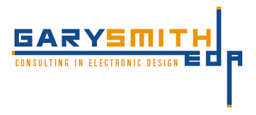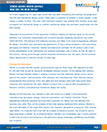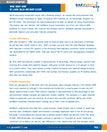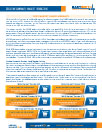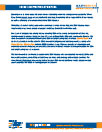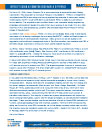The announcement of Mentor Graphics’ acquisition by Siemens is a huge step toward the convergence of the EDA and mechanical design markets. Siemens is a leading player in mechanical CAx design tools, while Mentor has an expansive EDA product portfolio. This acquisition shows that the future for the EDA industry is system-level design and that future is now.
This week, Japanese technology conglomerate SoftBank Group announced it will purchase semiconductor IP powerhouse ARM in a cash deal worth approximately $32 billion. What does this massive deal mean for EDA users and vendors? Gary Smith EDA offers our view of this extremely noteworthy acquisition and its impact on the EDA and electronic design industries.
21st annual write up of “must see” products at the 53rd DAC 2016. To post / reprint the list and/or use GSEDA logo, purchase the RV for $500. View the List for Free.
2014 marked the first year of really solid growth for electronic system level (ESL) tools, after years of promise as the next big thing in EDA. It seems the tide is finally turning and ESL technologies may now be experiencing their long-awaited user adoption in earnest. For the first time, ESL growth was higher than that of either the downstream CAE market or the EDA market as a whole.
Gary Smith EDA will continue its mission to support the EDA industry with our detailed market statistics and forecasting reports, consulting and advisory services, and strategy and analysis services under chief analyst Laurie Balch.

20th annual write up of “must see” products at the 52nd DAC 2015. To post / reprint the list and/or use GSEDA logo, purchase the RV for $500. View the List for Free.
19th annual write up of “must see” products at the 50th DAC 2013. To post / reprint the list and/or use GSEDA logo, purchase the RV for $500. View the List for Free.

As Mark Twain once said “The reports of my death have been greatly exaggerated”, and so goes it with DATE. The move from Nice, and before that Paris, to Grenoble was as successful as the move from Munich to Dresden. Not that I won’t miss Paris and Munich; however (read more…)

Dynamic Power in an SoC is controlled by two major variables; Gate Count and Frequency. Once the Power Budget is set, as in the case of mobile designs, designers must trade off these two variables. As the demand for more gates is growing designers are looking at lowering the average frequency of their designs. Microprocessor vendors that are still bragging about their Gigahertz processors are missing the point.

Review of Jim Hogan keynote Navigating the SoC Era where he discussed the reality of the IP Market. Review of Wally Rhines keynote From Volume to Velocity where he discussed the next challenge of verification is to lower the cost of verification in order to increase the number of SoC design starts, particularly from new start-ups.

Review of Steve Furber Future of Computing keynote where he reviewed the biologically-inspired, massively-parallel architectures of the human brain (with a link to his slides); Review of Philippe Magarshack’s keynote on how Technology R&D brings competitive advantage where he addresses the challenges of being an IDM in a Fab-Lite world; 2 common myths dispelled and growth of conference.
The announcement of Mentor Graphics’ acquisition by Siemens is a huge step toward the convergence of the EDA and mechanical design markets. Siemens is a leading player in mechanical CAx design tools, while Mentor has an expansive EDA product portfolio. This acquisition shows that the future for the EDA industry is system-level design and that future is now.
This week, Japanese technology conglomerate SoftBank Group announced it will purchase semiconductor IP powerhouse ARM in a cash deal worth approximately $32 billion. What does this massive deal mean for EDA users and vendors? Gary Smith EDA offers our view of this extremely noteworthy acquisition and its impact on the EDA and electronic design industries.
21st annual write up of “must see” products at the 53rd DAC 2016. To post / reprint the list and/or use GSEDA logo, purchase the RV for $500. View the List for Free.
2014 marked the first year of really solid growth for electronic system level (ESL) tools, after years of promise as the next big thing in EDA. It seems the tide is finally turning and ESL technologies may now be experiencing their long-awaited user adoption in earnest. For the first time, ESL growth was higher than that of either the downstream CAE market or the EDA market as a whole.
Gary Smith EDA will continue its mission to support the EDA industry with our detailed market statistics and forecasting reports, consulting and advisory services, and strategy and analysis services under chief analyst Laurie Balch.

20th annual write up of “must see” products at the 52nd DAC 2015. To post / reprint the list and/or use GSEDA logo, purchase the RV for $500. View the List for Free.
19th annual write up of “must see” products at the 50th DAC 2013. To post / reprint the list and/or use GSEDA logo, purchase the RV for $500. View the List for Free.

EDA, GPU, Linux, Parallel Computing & EE Times November 8th, 9th & 10th featured three conferences; IC CAD , ARM Techcon and ParCAD, which made for a busy but very interesting week. Just to touch the highlights; IC CAD ran out of printed programs, ARM Techcon featured a new GPU and an open source embedded software effort that should cut the ESL TAM in half (Linaro), and ParCAD proclaimed Parallel computing as just plain hard work.

Ok, so maybe I’m exaggerating, but Moshe’s (Xilinx) keynote at SNUG was certainly the first one I’ve seen. In the 1980s, the FPGA marketing establishment started exaggerating their capabilities. Moshe put an end to the exaggerated marketing claims because at 45nm an FPGA had enough gates to do true SoC designs.

DATE 2010 was a pleasant surprise and success. The venue was good; the technical conference was excellent; attendance was high quality with the continued shift to Systems and Embedded engineers and the show floor was busy. ‘Why was the show floor so poorly attended by ESL vendors?’ Poor EDA marketing
The announcement of Mentor Graphics’ acquisition by Siemens is a huge step toward the convergence of the EDA and mechanical design markets. Siemens is a leading player in mechanical CAx design tools, while Mentor has an expansive EDA product portfolio. This acquisition shows that the future for the EDA industry is system-level design and that future is now.
This week, Japanese technology conglomerate SoftBank Group announced it will purchase semiconductor IP powerhouse ARM in a cash deal worth approximately $32 billion. What does this massive deal mean for EDA users and vendors? Gary Smith EDA offers our view of this extremely noteworthy acquisition and its impact on the EDA and electronic design industries.
21st annual write up of “must see” products at the 53rd DAC 2016. To post / reprint the list and/or use GSEDA logo, purchase the RV for $500. View the List for Free.
2014 marked the first year of really solid growth for electronic system level (ESL) tools, after years of promise as the next big thing in EDA. It seems the tide is finally turning and ESL technologies may now be experiencing their long-awaited user adoption in earnest. For the first time, ESL growth was higher than that of either the downstream CAE market or the EDA market as a whole.
Gary Smith EDA will continue its mission to support the EDA industry with our detailed market statistics and forecasting reports, consulting and advisory services, and strategy and analysis services under chief analyst Laurie Balch.

20th annual write up of “must see” products at the 52nd DAC 2015. To post / reprint the list and/or use GSEDA logo, purchase the RV for $500. View the List for Free.
19th annual write up of “must see” products at the 50th DAC 2013. To post / reprint the list and/or use GSEDA logo, purchase the RV for $500. View the List for Free.

The Von Neumann compute model is the sequential single processor architecture found in most computers today. As the Power problem increased, the semiconductor vendors moved to a multi-core architecture…solving the performance problem but abandoning the Von Neumann architecture…putting into jeopardy all the companies that have made a living based on the Von Neumann compute model; Microsoft, Intel.
The announcement of Mentor Graphics’ acquisition by Siemens is a huge step toward the convergence of the EDA and mechanical design markets. Siemens is a leading player in mechanical CAx design tools, while Mentor has an expansive EDA product portfolio. This acquisition shows that the future for the EDA industry is system-level design and that future is now.
This week, Japanese technology conglomerate SoftBank Group announced it will purchase semiconductor IP powerhouse ARM in a cash deal worth approximately $32 billion. What does this massive deal mean for EDA users and vendors? Gary Smith EDA offers our view of this extremely noteworthy acquisition and its impact on the EDA and electronic design industries.
21st annual write up of “must see” products at the 53rd DAC 2016. To post / reprint the list and/or use GSEDA logo, purchase the RV for $500. View the List for Free.
2014 marked the first year of really solid growth for electronic system level (ESL) tools, after years of promise as the next big thing in EDA. It seems the tide is finally turning and ESL technologies may now be experiencing their long-awaited user adoption in earnest. For the first time, ESL growth was higher than that of either the downstream CAE market or the EDA market as a whole.
Gary Smith EDA will continue its mission to support the EDA industry with our detailed market statistics and forecasting reports, consulting and advisory services, and strategy and analysis services under chief analyst Laurie Balch.

20th annual write up of “must see” products at the 52nd DAC 2015. To post / reprint the list and/or use GSEDA logo, purchase the RV for $500. View the List for Free.
19th annual write up of “must see” products at the 50th DAC 2013. To post / reprint the list and/or use GSEDA logo, purchase the RV for $500. View the List for Free.

Congratulations DATE, you’ve pulled it off…becoming a major conference for Embedded Software development, especially that pertaining to Multi-Core/Multi-Processor systems… What was even more impressive was…its intention of becoming a true “systems” design automation (SDA) conference, using this year’s automotive emphasis to bring mechanical design to the table

This year’s DAC was a hard one to classify. However in the last year there were several panels that either questioned the meaning or existence of ESL design. Unless I missed something, there was nothing along these lines at DAC 2008. Somehow it had been replaced with an acceptance that like it or not we had entered the ESL area.

This year’s EDP conference in April focused on the continuing evolution of multi-core systems and their associated design problems. Semiconductor vendors reflected upon the difficulty of programming multicore platforms, the lack of software that could exploit the concurrency of the multicore design and the limiting nature of memory latency that holds down system speed…

GS EDA has been interviewing companies to uncover whether “Is 2008 going to be the year where analog design automation moves forward and catches up with digital design automation?” While there has been a shift away from in-house proprietary solutions to design tool integration, will DAC be the turning point?…

Trip report includes discussion of Jan Rabaey (UC Berkeley) keynote address, System-Level Design versus ESL versus System Design Automation, Network on Chips, model-based ESL versus language-based ESL, F.C. Tseng (TSMC) keynote address, Semiconductor Research Consortia, and Restrictive Design Rules…

While there have been some complaints on the quality of education for the new EE graduates, our experience has been positive…Recently some professors have been talking about a new engineering curriculum for embedded designers… We are seeing the need for an engineering curriculum for an entirely new breed of engineer…
Gary Smith EDA (GSEDA) is the leading provider of market intelligence and advisory services for the global Electronic Design Automation (EDA), Electronic System Level (ESL) design, and related technology markets.
Blogs Archives
Who’s Talking About Gary Smith EDA?
By Gary Smith EDA on November 17, 2016
Mentor Graphics, One of Big Three in Electronic Design Automation, Sells to Siemens for $4.5 Billion
By Gary Smith EDA on November 16, 2016
Electronic Design Magazine
Mentor Graphics, One of Big Three in Electronic Design Automation, Sells to Siemens for $4.5 Billion
By Gary Smith EDA on November 16, 2016
By Gary Smith EDA on October 26, 2016
By Gary Smith EDA on October 26, 2016
Tag Cloud
Agnisys
Aldec
ARM
ATopTech
Atrenta
Berkeley Design
CAD
Cadence
CAE
CAM
Carbon
Concept Engineering
DAC
Defacto
Emulation
ESL
Forte
IBM
IC CAD
IC Manage
Intel
IoT
ITRS
Jasper
JEDAT
Library Technology
Market Trends
Mentor
Multi-Platform
Oasys
PCB
ProPlus
RTL
Sage
Samsung
Solido
Sonics
Statistics
SVP
Synopsys
Tanner EDA
Trends
verification
Wallcharts
WTS@DAC
Popular Research
Recent Posts
Jul 21, 2016
May 23, 2016
© 2015 Gary Smith EDA. All Rights Reserved. | Terms of Use | Privacy Policy
[email protected] • ph: +1 (408) 985-2929 • fax +1 (408) 985-6611
